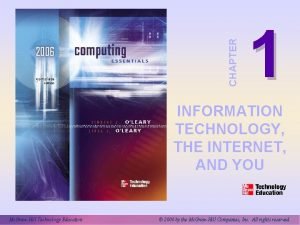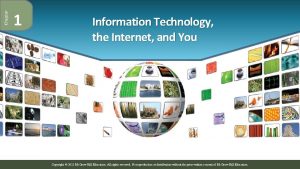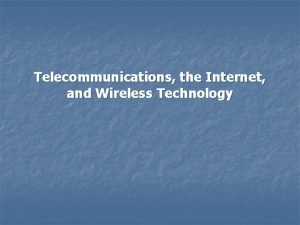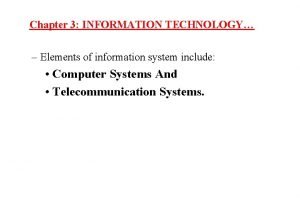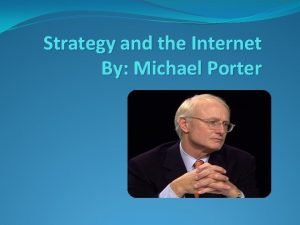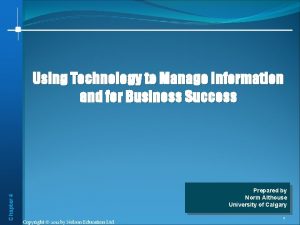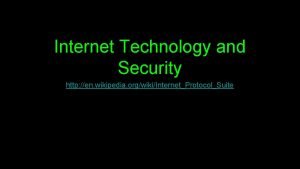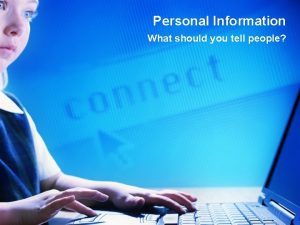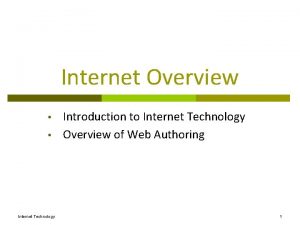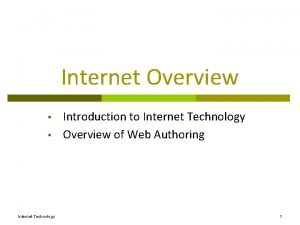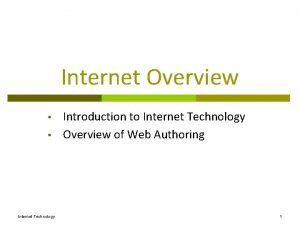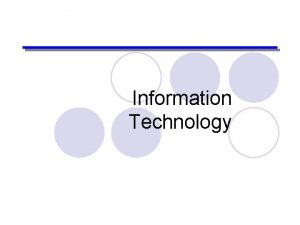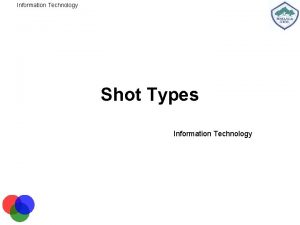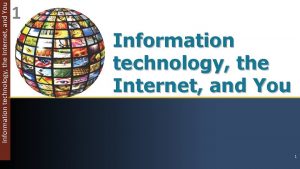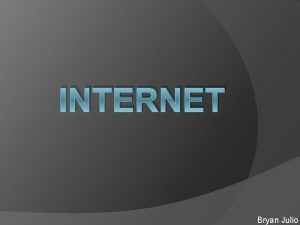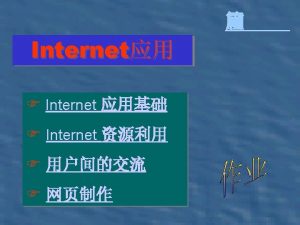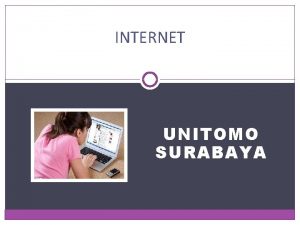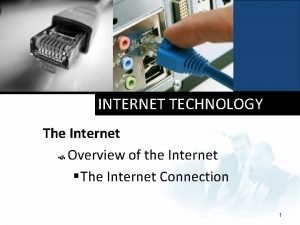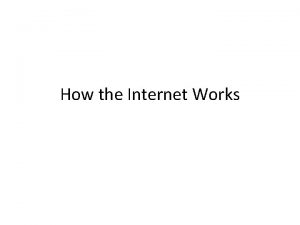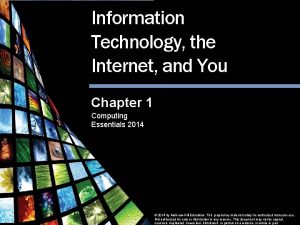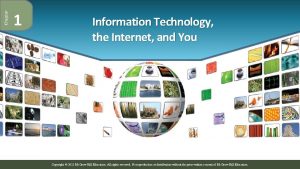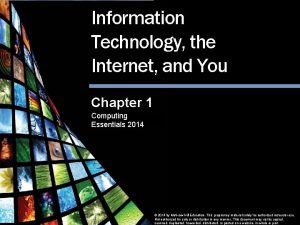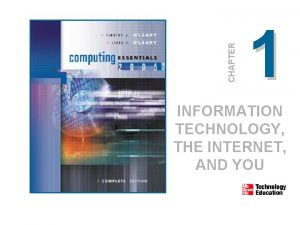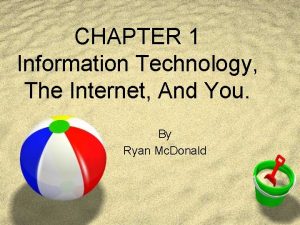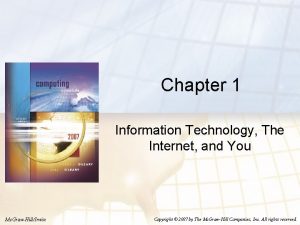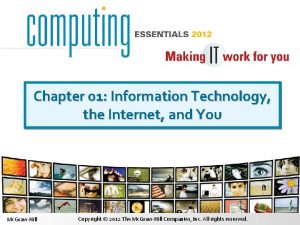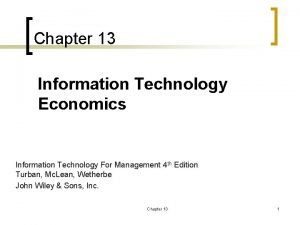Chapter 1 Information Technology the Internet and You



























- Slides: 27

Chapter 1 Information Technology, the Internet, and You Copyright © 2015 Mc. Graw-Hill Education. All rights reserved. No reproduction or distribution without the prior written consent of Mc. Graw-Hill Education.

Learning Objectives • Explain the parts of an information system: people, procedures, software, Computing Essentials 2015 • • hardware, data, and the Internet. Distinguish between system software and application software. Differentiate between the kinds of system software programs. Define and compare general purpose, specialized, and mobile applications. Identify the four types of computers and the four types of personal computers. Describe the different types of computer hardware, including the system unit, input, output, storage, and communication devices. Define data and describe document, worksheet, database, and presentation files. Explain computer connectivity, the wireless revolution, the Internet, and cloud computing. 1 -3

Introduction • Personal computers are common tools in all areas of life • New forms of learning have developed • College course does not have to be a quarter or Computing Essentials 2015 semester any longer • Computers offer many new ways to communicate 1 -4

Parts of an Information System • Hardware • Data • The Internet Computing Essentials 2015 • People • Procedures • Software 1 -5

People • Most important part of any system • Computer uses Business Medicine Education Entertainment Computing Essentials 2015 • • 1 -6

Software Computing Essentials 2015 There are two major kinds of software: • System Software • Application Software The purpose of application software is to convert raw data into information. 1 -7

System Software Computing Essentials 2015 • Enables application software to interact with computer hardware • Provides an interface so computer users can interact with application programs • Background software helps manage resources • Collection of programs • Operating System • Utilities • Device Drivers 1 -8

System Software (continued) Computing Essentials 2015 • Operating System • Coordinates computer resources • Provides the user interface • Runs applications 1 -9

System Software (cont. ) Computing Essentials 2015 • Utilities • Perform specific tasks related to managing computer resources • Housekeeping tasks • Antivirus Program • Device Drivers • Programs designed to enable the computer to communicate with input or output devices 1 -10

Application Software • End-user software • Types Computing Essentials 2015 1. General-Purpose applications 2. Specialized applications 3. Mobile apps 1 -11

Hardware – Types of Computers § Personal computers § Midrange computers Computing Essentials 2015 (servers) § Mainframe computers § Supercomputers 1 -12

Personal Computer Types • Tablet PC • Handheld Computing Essentials 2015 • Desktop • Laptop (Notebook, Netbook) 1 -13

Personal Computer Hardware • Four basic categories of Computing Essentials 2015 equipment • System Unit • Input/Output Devices • Secondary Storage • Communications 1 -14

System Unit • Most important components • Microprocessor (Processor) Computing Essentials 2015 • Central Processing Unit (CPU) • Memory (RAM) • Random Access Memory (Main memory) • Holds programs and data currently being processed • Holds processed information before it is output • Temporary storage; contents are lost when power is off (volatile) 1 -15

Input/Output Devices Input • Keyboard • Mouse Computing Essentials 2015 Output • Printer • Display 1 -16

Secondary Storage • Holds data and programs even if power is off (non-volatile) • Hard disk (magnetic storage) • Solid-state storage Computing Essentials 2015 • No moving parts • More reliable • Requires less power • Optical disc • Laser technology • Greater capacity • CDs, DVDs, Blu-ray discs 1 -17

Communications Computing Essentials 2015 • Communication devices, such as modems, provide personal computers with the ability to communicate with other computer systems • Modems modify audio, video and other types of data into a form that can be transmitted across telephone lines 1 -18

Data Computing Essentials 2015 • Raw, unprocessed characters (letters, numbers, symbols) • Processed data becomes information • Digital data is stored electronically in files • Types of files • Documents • Spreadsheets • Databases • Presentations 1 -19

Document Files • Created by word Computing Essentials 2015 processing programs • Memos • Letters • Term papers 1 -20

Spreadsheet Files • Created by electronic spreadsheets to analyze things like Computing Essentials 2015 budgets and to predict sales 1 -21

Database Files • Typically created by database management systems to contain Computing Essentials 2015 highly structured and organized data 1 -22

Presentation Files • Created by presentation graphics programs to prepare Computing Essentials 2015 presentation materials. 1 -23

Connectivity and the Mobile Internet • Connectivity • Sharing of information • Mobile/Wireless devices • Cloud computing and the Wireless Revolution • Computer networks Computing Essentials 2015 • Computers connected by a communication system • Largest network is the Internet • Cloud Computing • Uses the Internet and the Web to shift many computer activities from a user’s computer to computers on the Internet 1 -24

Careers in Information Technology Computing Essentials 2015 • For a complete listing of careers, visit http: //www. mhhe. com/ce 2015/ • Select Student Edition and then Careers Career Description Webmaster Develops and maintains websites and web resources. See page 52 Software Engineer Analyzes users’ needs and creates application software. See page 81 Computer Support Specialist Provides technical support to customers and other users. See page 105 Computer Technician Repairs and installs computer components and systems. See page 132 Technical Writer Prepares instruction manuals, technical reports, and other scientific or technical documents. See page 159 Network Administrator Configures and maintains computer networks. See page 213 1 -25

Computing Essentials 2015 A Look to the Future Using and Understanding Information Technology • The Internet and the Web • Powerful Software • Powerful Hardware • Security, Privacy and Ethics • Organizations • Changing Times 1 -26

Open-Ended Questions (Page 1 of 2) • Explain the parts of an information system. What part do people play in this system? • What is system software? What kinds of programs are included in system software? Computing Essentials 2015 • Define and compare general-purpose applications, specialized, applications and apps. Describe some different types of general-purpose applications. Describe some types of specialized applications. 1 -27

Open-Ended Questions (Page 2 of 2) • Describe the different types of computers. What is the most common type? What are the types of personal computers? • What is connectivity? What are wireless devices and the wireless revolution? What is Computing Essentials 2015 a computer network? What are the Internet and the Web? What is cloud computing? 1 -28
 Information technology the internet and you
Information technology the internet and you Chapter 1 information technology the internet and you
Chapter 1 information technology the internet and you Telecommunications, the internet, and wireless technology
Telecommunications, the internet, and wireless technology Telecommunications, the internet, and wireless technology
Telecommunications, the internet, and wireless technology Information technology chapter 3
Information technology chapter 3 Internet or internet
Internet or internet Strategy and the internet
Strategy and the internet Internet technology
Internet technology Internet technology wikipedia
Internet technology wikipedia Tell me what you eat and i shall tell you what you are
Tell me what you eat and i shall tell you what you are You give personal information when you tell
You give personal information when you tell Hình ảnh bộ gõ cơ thể búng tay
Hình ảnh bộ gõ cơ thể búng tay Frameset trong html5
Frameset trong html5 Bổ thể
Bổ thể Tỉ lệ cơ thể trẻ em
Tỉ lệ cơ thể trẻ em Voi kéo gỗ như thế nào
Voi kéo gỗ như thế nào Chụp tư thế worms-breton
Chụp tư thế worms-breton Bài hát chúa yêu trần thế alleluia
Bài hát chúa yêu trần thế alleluia Các môn thể thao bắt đầu bằng tiếng nhảy
Các môn thể thao bắt đầu bằng tiếng nhảy Thế nào là hệ số cao nhất
Thế nào là hệ số cao nhất Các châu lục và đại dương trên thế giới
Các châu lục và đại dương trên thế giới Công của trọng lực
Công của trọng lực Trời xanh đây là của chúng ta thể thơ
Trời xanh đây là của chúng ta thể thơ Mật thư anh em như thể tay chân
Mật thư anh em như thể tay chân 101012 bằng
101012 bằng độ dài liên kết
độ dài liên kết Các châu lục và đại dương trên thế giới
Các châu lục và đại dương trên thế giới Thể thơ truyền thống
Thể thơ truyền thống
